Electric companies embrace enhanced reporting on sustainability initiatives

Electric power companies say they are moving beyond providing safe, reliable, affordable and clean energy through ongoing investments in sustainability initiatives, and the industry is moving toward reporting that information to investors in a clearer and more concise way.
Electric utility investors and the general public are increasingly focused on environmental, social, governance (ESG) and sustainability issues, as evidenced by the release last week of the first version of a voluntary ESG/sustainability reporting template from the Edison Electric Institute (EEI). The more standardized reporting metrics that many investor-owned utilities are expected to use going forward reflects both qualitative and quantitative data and highlights companies’ capital expenditures that help advance clean energy and contribute to a more sustainable future.
At Pacific Gas and Electric Company (PG&E), ESG/sustainability reporting is considered an ongoing component of the firm’s continuous improvement mindset, Director of Corporate Sustainability Chris Benjamin told Daily Energy Insider. “It really complements our other sustainability reporting efforts” that had been adopted before the EEI template was developed.
“Sharing this information is not new for us; it’s simply a different way” to communicate it to investors and stakeholders, Benjamin said, adding the company has had a decades-long commitment to sustainability reporting.
San Francisco, Calif.-based PG&E released its first annual environmental report in 1990, and its first community responsibility report came out in 2005. Later, the company “broadened the lens” to incorporate sustainability and began including social and economic indicators, he said.
Benjamin noted that California has some of the nation’s most progressive climate and energy policies. In that milieu, “Our stakeholders expect to learn about our sustainability vision and progress, and have for many years.”
PG&E’s involvement in creating the ESG reporting template in a pilot project offered the company an opportunity to work together with industry peers in a structured and voluntary way, he said.
Working on the template development provided the companies involved a useful vehicle for the industry in thinking through what would be the most important information to provide to investors and presenting it “in a way that engages our stakeholders in the process.”
At the same time, the new reporting format gives individual companies a “source of benchmarking for our performance against peers” in the industry, he said.
“We think that EEI has done a great job in identifying a standardized set of metrics,” Benjamin added.
David Scanzoni, a spokesperson for Duke Energy, said investors have come to expect large companies to produce ESG/sustainability reports on a regular basis. “Investors want information about every tentacle of a company’s operations” regarding sustainability, environmental protection, employee relations, governance and social responsibility, he said.
Indeed, some companies have been on the forefront of ESG/sustainability reporting for years, with the new reporting template offering a uniform, concise and accessible format across companies for investors and others interested in the information.
For example, Charlotte N.C.-based Duke Energy had a head start on sharing these metrics with the public given that the company has conducted sustainability reporting for 12 years, Scanzoni said. The company will soon be releasing its 2017 sustainability report.
Amid heightened public interest, Duke issued its first climate report last year, Scanzoni said, and the company has been “very aggressively proactive on providing information on these topics.”
Duke Energy began growing its renewables portfolio in 2007, illustrating its commitment to sustainable electric power, according to Scanzoni, and it now has more than 5,400 megawatts of wind, solar and biomass capacity owned or under contract. He also noted that Duke is expected to recycle 80 percent of its solid waste in 2018.
Large companies like Duke are committed to producing ESG/sustainability reporting metrics and improving the information quality over the coming years as new types of information are sought and new data become available. Scanzoni pointed out, “It’s in the interest of companies and investors to have a good dialogue and discussion and be transparent about this kind of information.”
Transparent ESG/sustainability reporting pays off in other ways besides providing investor appeal. “It builds a lot of bridges between other organizations” such as environmental groups and the social responsibility community and prompts input from those sources for Duke Energy “on areas we can improve,” he added.
